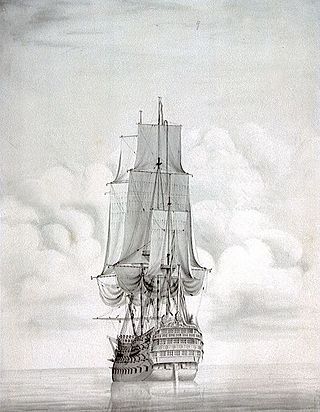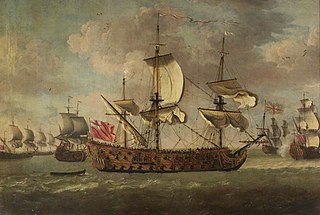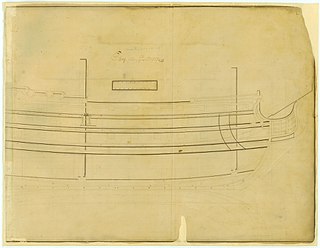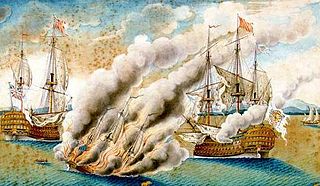
HMS Vanguard was a 90-gun second-rate ship of the line of the Royal Navy, built at Portsmouth Dockyard and launched in 1678.

HMS Princess Royal was a 90-gun second rate ship of the line of the Royal Navy, launched on 18 October 1773 at Portsmouth. During her career she was upgraded to a 98-gun ship, by the addition of eight 12 pdr guns to her quarterdeck.
HMS Greenwich was a 54-gun fourth-rate ship of the line of the Royal Navy, built by Christopher Pett at Woolwich Dockyard and launched in 1666.

HMS Swiftsure was a 70-gun third-rate ship of the line of the Royal Navy, built by Sir Anthony Deane at Harwich, and launched in 1673. By 1685 she had been reduced to a 66-gun ship.

HMS Oxford was a 54-gun fourth-rate ship of the line of the Royal Navy, built by Francis Baylie in Bristol and launched in June 1674. Her guns comprised twenty-two 24-pounders on the lower deck, with twenty-two large sakers (8-pounders) on the upper deck and ten smaller sakers (5-pounders) on the quarterdeck.
Lyme was a 52-gun third rate Speaker-class frigate built for the navy of the Commonwealth of England at Portsmouth, and launched in 1654.
Worcester was a 48-gun third rate frigate built for the navy of the Commonwealth of England at Woolwich Dockyard, and launched in 1651.

HMS Dover was a 40-gun fourth-rate frigate of the Royal Navy, originally built for the navy of the Commonwealth of England at Shoreham by William Castle, and launched in 1654. By 1677, her armament had been increased to 48 guns.

HMS Ossory was a 90-gun second rate ship of the line of the Royal Navy, launched on 24 August 1682 at Portsmouth Dockyard. She was renamed HMS Prince in 1705.

HMS Russell was an 80-gun third rate ship of the line of the Royal Navy, launched at Portsmouth Dockyard on 3 June 1692.

HMS Humber was an 80-gun third rate ship of the line of the Royal Navy, launched at Hull on 30 March 1693.
HMS Dorsetshire, the first Royal Navy ship to be named after the county of Dorset, was an 80-gun third rate ship of the line of the Royal Navy, launched at Southampton on 8 December 1694.

HMS Canterbury was a 60-gun fourth-rate ship of the line of the Royal Navy, launched at Deptford on 18 December 1693.

HMS Exeter was a 60-gun fourth-rate ship of the line of the Royal Navy, launched at Portsmouth Dockyard on 26 May 1697.

HMS Ipswich was a 70-gun third-rate ship of the line of the Royal Navy, launched at Harwich on 19 April 1694.

HMS Bedford was a 70-gun third rate ship of the line of the Royal Navy, launched at Woolwich Dockyard on 12 September 1698. She carried twenty-two 24-pounder guns and four (18-pounder) culverins on the lower deck; twenty-six 12-pounder guns on the upper deck; fourteen (5-pounder) sakers on the quarterdeck and forecastle; and four 3-pounder guns on the poop or roundhouse.

HMS Namur was a 90-gun second rate ship of the line of the Royal Navy, launched at Woolwich Dockyard in 1697.

HMS Mary was a 60-gun fourth rate ship of the line of the Royal Navy, built at Chatham Dockyard and launched on 12 May 1704.
HMS Sunderland was a 60-gun fourth rate ship of the line of the Royal Navy, built to the 1719 Establishment at Chatham Dockyard, and launched on 30 April 1724.
HMS Worcester was a 60-gun fourth rate ship of the line of the Royal Navy, built by Joseph Allin the younger at Portsmouth Dockyard to the 1733 proposals of the 1719 Establishment, and launched on 20 December 1735.















